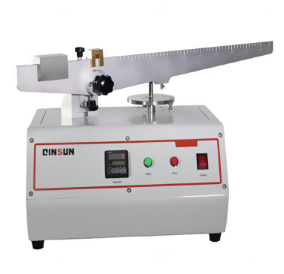- Qinsun Instruments Co., Ltd.
- Tell:+86-21-6780 0179
- Phone:+86-17740808215
- Address:No. 2578 Minhang District Gu Dai Road, Shanghai
- Contact:Mr. Li
- QQ:846490659
Scratch resistance tester

Product Introduction:
Used to evaluate the cutting, scratching, planing, scraping, and carving properties of materials. Its application areas include: rigid organic materials, plastics, glass, and so on. The scratch testing machine for artificial boards is used to test the scratch resistance of material surfaces. It is developed for testing the scratch resistance of various types of artificial boards and decorative artificial boards. It can meet the requirements of GB/T17657-1999 "Test Methods for Physical and Chemical Properties of Artificial Board and Decorative Artificial Board" and conduct "scratch resistance performance measurement" tests. It is an ideal testing equipment for quality inspection departments and artificial board production enterprises at all levels, and can provide you with accurate test results.
Scratch tester application:
Taber 551 is used to evaluate the cutting, scratching, planing, scraping, and carving properties of materials. Its application areas include: rigid organic materials, coating adhesives, powder coatings, anodized materials, soft metals, plastics, glass, and so on. It can also be used to test the adhesive quality of the same material, protective coating, and the ultimate performance of similar materials. Taber 551 is easy to operate and easy to move, and can test materials that are 1/2 "to 4" thick, square or circular.
Meets standards:
GB/T17657-1999
ISO 4586-2
JIS K6902
Federal series standards
Terrazzo 90322-9E-1
UNI 9428 Furniture
AS/NZS AS2924.2
ASTM C217
CEN series standards
DIN 53 799
DIN 68 861-4
Technical parameters:
1. Maximum test pressure: 5N
2. Rotation speed of the specimen: 5 ± 1r/min
3. Test force accuracy: ± 2%
4. Maximum size of specimen: Φ 90~ Φ 100mm
5. External dimensions: 120 x 120 x 480mm
6. Weight: 15kg
Scratch tester operation:
Before installing the sample, it is necessary to adjust the scale to the appropriate height based on the thickness of the sample. Install precision cutting tools on the scale and place them on the sample. Start the instrument and rotate the turntable at a constant speed to ensure accurate measurement results. By changing the load of the cutting tool, you can evaluate the material's shear or scratch resistance performance.
The design of the weighing rod of the instrument allows it to be level with the sample and turntable, and can be raised or lowered according to actual needs. In addition, the weighing rod can also be lifted and suspended in the air to facilitate the operator's removal of the sample. By changing the position of the sliding weight, the total load on the sample can be adjusted within the range of 0-1000g. Cutting tools can choose to use tungsten carbide cutting tools or conical drilling stones.
The test results can be visually judged using a randomly equipped 10x magnifying glass, and users can also observe using a high-precision optical microscope.





